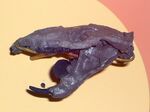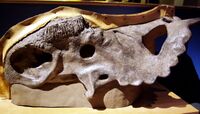Earth:St. Mary River Formation
| St. Mary River Formation Stratigraphic range: 71.9–67 Ma | |
|---|---|
 Strata of the St. Mary River Formation at the St. Mary Reservoir spillway. | |
| Type | Geological formation |
| Underlies | Willow Creek Formation |
| Overlies | Bearpaw Formation |
| Thickness | up to 762 metres (2,500 ft) |
| Lithology | |
| Primary | Sandstone, shale[1] |
| Other | Mudstone, coal |
| Location | |
| Coordinates | [ ⚑ ] : 49°36′N 114°06′W / 49.6°N 114.1°W |
| Paleocoordinates | [ ⚑ ] 49°36′N 86°30′W / 49.6°N 86.5°W |
| Region | |
| Country | |
| Type section | |
| Named for | St. Mary River |
| Named by | George Mercer Dawson[2] |
| Year defined | 1883 |
| Lua error in Module:Location_map/multi at line 27: Unable to find the specified location map definition: "Module:Location map/data/Alberta" does not exist. | |
The St. Mary River Formation is a geologic formation of Late Cretaceous (71.9-67 Ma[3]) age of the Western Canada Sedimentary Basin in southwestern Alberta and northwesternmost Montana.[4][5] It was first described from outcrops along the St. Mary River by George Mercer Dawson in 1883, and it takes its name from the river.
Fossils from the formation include remains of dinosaurs,[6] as well as bivalve shells, plant fossils, and trace fossils.[7]
Lithology
The St. Mary River Formation is generally considered to consist of two units. The lower 30–60 meters (98–197 ft) of the formation was deposited in brackish water environments, and is characterized by fine-grained sandstones, grey shales, coquinoid beds, carbonaceous mudstones and coal beds. The remainder of the formation was deposited in freshwater fluvial and floodplain environments and is characterized by interbedded sandstone and siltstone, with minor occurrences of carbonaceous shale and coal.
Thickness and distribution
The St. Mary River Formation is part of an eastward-thinning wedge of sediments derived from the erosion of the mountains to the west. It is about 762 metres (2,500 ft) thick in the exposures along the Crowsnest and Castle Rivers, and about 457 metres (1,500 ft) thick along the Oldman River.
Relationship to other units
The St. Mary River Formation conformably overlies the Blood Reserve Sandstone, or the Bearpaw Formation where the Blood Reserve Sandstone is absent, and it is conformably overlain by the Willow Creek Formation. It extends from Glacier County, Montana to as far north as the Little Bow River in Alberta, where it grades into and intertongues with the contemporaneous strata of the Horseshoe Canyon Formation.[4][5]
Fossil content
Flora
Eighteen species of plant leaves were described from the St. Mary River Formation in 1949.[8] More recent work downstream from the St. Mary Reservoir increased the total to at least 32 species. The assemblage includes remains of ferns, Ginkgo, conifers,[9] a Trapa-like plant,[10] and at least six types of large monocot leaves in addition to a sabaloid palm.[9]
| Plants | |||||
|---|---|---|---|---|---|
| Genus | Species | Presence | Material | Notes | Images |
| Cardstonia | C. tolmanii | Near Cardston, Alberta.[9] | Belongs in Limnocharitaceae. | ||
| Hydropteris | H. pinnata | "Riverbank exposure on the north side of the St. Mary River approx. 50 m below the spillway of the St. Mary Reservoir, east of Cardston, Alberta."[11] | Large segments of intact plants.[11] | A hydropteridale fern. | |
| Tolmania | T. aquatica | Near Cardston, Alberta.[12] | "Sixteen compression/ impression specimens".[12] | A floating aquatic angiosperm. | |
| Trapago | T. angulata | Southern Alberta.[10] | "Nearly 500 specimens of various isolated and attached organs".[10] | ||
| Zlatkovia | Z. crenulata | Near Cardston, Alberta.[13] | "Sixty-seven coalified compression specimens of leaves, one attached to a stem".[13] | An amphibious eudicot. | |
Molluscs
Beds of Ostrea and Corbicula shells are common in the basal, brackish water portion of the formation. The overlying freshwater beds include shells of freshwater and terrestrial molluscs. Shells of unionid freshwater mussels are common in the fluvial sandstones.[7]
Mammals
The mammals of the St. Mary River Formation were described by Sloan and Russell in 1974.[14]
| Mammals | |||||
|---|---|---|---|---|---|
| Genus | Species | Presence | Material | Notes | Images |
| Cimolodon | C. nitidus | Locality 11, 15 miles north of Lundbreck, Alberta.[14] | NMC 17667, a right M2.[14] | A cimolodontid. | |
| Cimolomys | C. gracilis | Scabby Butte, Alberta.[14] | "NMC 17662, 17663, 17664, 3 tooth fragments from at least 2 individuals."[14] | A cimolomyid. | |
| Didelphodon? | D.? sp. | Scabby Butte, Alberta.[14] | "ROM 7848, the badly worn trigonid of a right molar."[14] | ||
| Eodelphis? | E.? sp. | Scabby Butte, Alberta.[14] | "ROM 7849, a worn, broken right molar".[14] | ||
| Leptalestes | L. toevsi | Montana.[15] | A pediomyid. | ||
| Meniscoessus | M. conquista | Scabby Butte, Alberta.[14] | "3 teeth from at least 2 individuals (ROM 7846, 7847, 7850)".[14] | A cimolomyid. | |
| Mesodma | M. cf. thompsoni | Scabby Butte, Alberta.[14] | NMC 17665.[14] | ||
| Miacidae? | Genus and species undetermined. | Scabby Butte, Alberta.[14] | "NMC 9821, trigonid of a left lower molar".[14] | Assignment to Miacidae is tentative until the complete tooth is known. | |
| Nidimys | N. occultus | Montana.[15] | A ptilodontoid. | ||
| Paracimexomys | P. propriscus | Montana.[15] | A multituberculate. | ||
| Pediomys | P. cf. cooki | Scabby Butte, Alberta.[14] | NMC 21307, buccal portion of right upper molar.[14] | ||
| P. cf. krejcii | Scabby Butte, Alberta.[14] | NMC 9820, right M1.[14] | |||
| Ptilodontoidea | Genus and species indet. | Montana.[15] | MOR 2535.[15] | A ptilodontoid comparable in size to the smallest Mesodma species.[15] | |
| Turgidodon | T. russelli | Montana.[15] | An alphadontid. | ||
Dinosaurs
Dinosaur tracks
The St. Mary River Formation has produced relatively few dinosaur fossils from its outcrops in southwestern Alberta.[16] However, footprints and trackways have been found along the St. Mary and Oldman Rivers. More than 100 track-bearing stratigraphic units were documented in one section 177 metres (580 ft) thick, which is one of the highest densities of track-bearing layers reported from any succession. One footprint from the formation includes the first record of skin impressions from the bottom of a hadrosaur foot.[17]
Ornithischians
| Ornithischians | ||||||
|---|---|---|---|---|---|---|
| Genus | Species | Location | Stratigraphic position | Material | Notes | Images |
|
A. ornatus[19] |
|
Remains later found to be referrable to Anchiceratops, but it's not known what species.[18] |
||||
|
E. longiceps[20] |
|
|||||
|
M. cerorhynchus[21] |
|
|||||
|
P. canadensis[18] |
|
|||||
|
R. peterhewsi |
|
|||||
Theropods
| Theropods | ||||||
|---|---|---|---|---|---|---|
| Genus | Species | Location | Stratigraphic position | Material | Notes | Images |
|
||||||
|
cf. Saurornitholestes sp.[23] |
|
|||||
|
Troodon sp."[24] |
|
|||||
See also
- List of dinosaur-bearing rock formations
References
- ↑ Lexicon of Canadian Geologic Units. "St. Mary River Formation". http://cgkn1.cgkn.net/weblex/weblex_litho_detail_e.pl?00053:014440. Retrieved 2010-01-01.
- ↑ Dawson, G.M., 1883. Preliminary report on the geology of the Bow and Belly river region, Northwest Territory, with special reference to the coal deposits. Geological Survey of Canada, Report of Progress for 1880-81-82, Part B.
- ↑ Fowler, Denver Warwick (2017-11-22). "Revised geochronology, correlation, and dinosaur stratigraphic ranges of the Santonian-Maastrichtian (Late Cretaceous) formations of the Western Interior of North America". PLOS ONE 12 (11): e0188426. doi:10.1371/journal.pone.0188426. ISSN 1932-6203. PMID 29166406. Bibcode: 2017PLoSO..1288426F.
- ↑ 4.0 4.1 Mossop, G.D. and Shetsen, I., (compilers), Canadian Society of Petroleum Geologists (1994). "The Geological Atlas of the Western Canada Sedimentary Basin, Chapter 24: Upper Cretaceous and Tertiary strata of the Western Canada Sedimentary Basin". http://www.ags.gov.ab.ca/publications/wcsb_atlas/a_ch24/ch_24.html.
- ↑ 5.0 5.1 Prior, G. J., Hathaway, B., Glombick, P.M., Pana, D.I., Banks, C.J., Hay, D.C., Schneider, C.L., Grobe, M., Elgr, R., and Weiss, J.A. (2013). "Bedrock Geology of Alberta. Alberta Geological Survey, Map 600". http://www.ags.gov.ab.ca/publications/abstracts/MAP_600.html.
- ↑ Weishampel, David B; et al. (2004). "Dinosaur distribution (Late Cretaceous, North America)." In: Weishampel, David B.; Dodson, Peter; and Osmólska, Halszka (eds.): The Dinosauria, 2nd, Berkeley: University of California Press, pp. 574-588. ISBN:0-520-24209-2.
- ↑ 7.0 7.1 Hamblin, A. P. (1998). "Edmonton Group/St Mary River Formation: Summary of Literature and Concepts. Geological Survey of Canada, Open File 3578". ftp://ftp2.cits.rncan.gc.ca/pub/geott/ess_pubs/209/209584/of_3578.pdf. Retrieved 2014-01-31.[yes|permanent dead link|dead link}}]
- ↑ Bell, W.A. 1949. Uppermost Cretaceous and Paleocene floras of western Canada. Geological Survey of Canada, Bulletin 13, 231 p.
- ↑ 9.0 9.1 9.2 Riley, M.G. and Stockey, R.A.(2004). Cardstonia tolmanii gen. et sp. nov (Limnocharitaceae) from the Upper Cretaceous of Alberta, Canada. International Journal of Plant Sciences 165(5): 897-916.
- ↑ 10.0 10.1 10.2 Stockey, R.A. and Rothwell, G.W. (1997). The aquatic angiosperm Trapago angulata from the Upper Cretaceous (Maastrictian) St. Mary River Formation of southern Alberta. International Journal of Plant Sciences 158(1): 83-94,
- ↑ 11.0 11.1 Rothwell, G. W.; Stockey, R. A. (1994). "The Role of Hydropteris pinnata gen. et. sp. nov. In Reconstructing the cladistics of Heterosporous Ferns." (in en). https://era.library.ualberta.ca/items/afa82043-f7ad-4ff4-a959-f35f318c5aac.
- ↑ 12.0 12.1 Edmonds, Nathaniel L.; Stockey, Ruth A.; Rothwell, Gar W. (2022-08-04). "Late Cretaceous Aquatic Vegetation: Tolmania aquatica gen. et sp. nov., from Southern Alberta, Canada". International Journal of Plant Sciences 183 (7): 567–575. doi:10.1086/721261. ISSN 1058-5893. https://www.journals.uchicago.edu/doi/abs/10.1086/721261.
- ↑ 13.0 13.1 Rothwell, Gar W.; Stockey, Ruth A. (2022-08-08). "Enriching our knowledge of Late Cretaceous wetland plant communities: Zlatkovia crenulata gen. et sp. nov., an amphibious angiosperm from the St. Mary River Formation, Alberta, Canada" (in en). Cretaceous Research 140: 105328. doi:10.1016/j.cretres.2022.105328. ISSN 0195-6671. https://www.sciencedirect.com/science/article/pii/S0195667122001926.
- ↑ 14.00 14.01 14.02 14.03 14.04 14.05 14.06 14.07 14.08 14.09 14.10 14.11 14.12 14.13 14.14 14.15 14.16 14.17 14.18 Sloan, R.E. and Russell, L.S. 1974. Mammals of the St. Mary River Formation (Cretaceous) of southwestern Alberta. Life Sciences Contributions, Royal Ontario Museum, Number 95.
- ↑ 15.0 15.1 15.2 15.3 15.4 15.5 15.6 Hunter, John P.; Heinrich, Ronald E.; Weishampel, David B. (2010-05-18). "Mammals from the St. Mary River Formation (Upper Cretaceous), Montana". Journal of Vertebrate Paleontology 30 (3): 885–898. doi:10.1080/02724631003763490. ISSN 0272-4634. https://www.researchgate.net/publication/236153689.
- ↑ Ryan, M. J., and Russell, A. P., 2001. Dinosaurs of Alberta (exclusive of Aves): In: Mesozoic Vertebrate Life, edited by Tanke, D. H., and Carpenter, K., Indiana University Press, Introduction, page 281.
- ↑ Currie, P.J., Nadon, G.C. and Lockley, M.G. (1991). Dinosaur footprints with skin impressions from the Cretaceous of Alberta and Colorado. Can. J. Earth Sci. 28: 102-115.. doi:10.1139/e91-009. http://doc.rero.ch/record/14615/files/PAL_E2306.pdf.
- ↑ 18.00 18.01 18.02 18.03 18.04 18.05 18.06 18.07 18.08 18.09 18.10 18.11 "1.4 Alberta, Canada; 13. St. Mary River Formation," in Weishampel, et al. (2004). Pages 577-578.
- ↑ Listed as "? A. ornatus" in "1.4 Alberta, Canada; 13. St. Mary River Formation," in Weishampel, et al. (2004). Pages 577-578.
- ↑ 20.0 20.1 Listed as "Edmontonia cf. longiceps" in "1.4 Alberta, Canada; 13. St. Mary River Formation," in Weishampel, et al. (2004). Pages 577-578.
- ↑ 21.0 21.1 21.2 "3.11 Montana, United States; 11. St. Mary River Formation," in Weishampel, et al. (2004). Pages 583-584.
- ↑ Brown, Caleb M.; Henderson, Donald M. (June 4, 2015). "A new horned dinosaur reveals convergent evolution in cranial ornamentation in ceratopsidae". Current Biology (online). doi:10.1016/j.cub.2015.04.041.
- ↑ 23.0 23.1 Listed as "cf. Saurornitholestes sp." in "1.4 Alberta, Canada; 13. St. Mary River Formation," in Weishampel, et al. (2004). Pages 577-578.
- ↑ 24.0 24.1 Listed as "? Troodon sp." in "1.4 Alberta, Canada; 13. St. Mary River Formation," in Weishampel, et al. (2004). Pages 577-578.
 |





